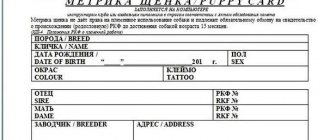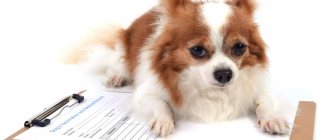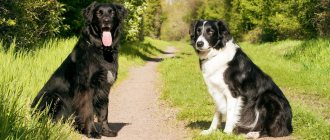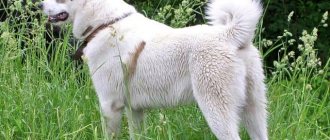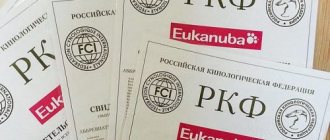The need for documents for a dog
Various documents are drawn up for dogs to solve the following problems:
- guarantee the purity of the breed to the buyer;
- confirm belonging to a certain breed - this is especially important in puppyhood, since the exterior will change;
- provide information about ancestors - this is important not only for the pedigree, but also allows you to predict possible genetic or hereditary problems;
- provide the opportunity to participate in exhibitions and competitions;
- transport the dog to other cities and countries;
- Confirm and monitor your pet's health status.
Documents of RKF and SKOR - are there any differences?
There are two large organizations in Russia that unite professional breeders and amateur dog breeders. The most numerous is RKF. The metrics and certificates issued by the Russian Cynological Federation are recognized as valid at the global level. Expert assessments by specialists from this organization allow animals to be exhibited at shows of any level - national and international.
RKF holds, along with national and international exhibitions, the results of which are recognized by the International Cynological Association - FCI. Metrics and pedigrees issued by the RKF have more weight than those issued by SKOR. The “Certificate of Origin” issued by the RKF opens up the opportunity for pets to participate in exhibitions, both national and international, held abroad.
Another thing is SKOR. This abbreviation stands for the Union of Cynological Associations of Russia. The national organization issues metrics that have weight only in Russia and neighboring countries. Therefore, a pet can participate only at exhibitions held in its country.
Several years ago, SCOR documents were recognized by the RKF; they could even be exchanged for RKF pedigrees after participating in several exhibitions with a positive assessment of the dog by experts. This path is now closed. The reason is that the procedure for obtaining SCOR documents is too simple. They are received mainly by those who do not dream of their favorite’s victories at the international level. If the puppy’s parents do not have documents, but their breed is beyond doubt, then you can go this way:
- participate in the SKOR exhibition;
- get an expert description and opinion on the breed;
- register the dog;
- exchange it for a pedigree.
Puppy inspection certificate
When the puppies are 1.5 months old, it is necessary to certify the litter. This should be done by dog handlers. Activation is carried out at the club or its representatives go to the breeder’s home. Specialists examine the puppies, assess the condition of their mother and living conditions. All information is entered into the inspection report. At the same stage, branding is carried out.
The puppy inspection report must indicate:
- mating registration number and date;
- information about parents and owner;
- number of puppies;
- compliance with the characteristics of the breed at this age with their indication;
- coloring
Puppies can be registered on our website.
Exterior defects or defects must be noted in the report. You should not sell such puppies before registration, as they will be considered ordinary mongrels. Not all buyers are interested in participating in exhibitions and competitions, but the breed is important.
Before registration, each puppy must have a nickname. The entire litter is named by one letter, and it is determined by the head of the club. When choosing nicknames, it is recommended to take into account the characteristics of the breed and exclude coincidence with famous champions and exhibition winners. Often the dog's pet name is different, since in documents it may consist of several words or may not sound very convenient.
Key mating rules and advice from dog breeders
Basic (sometimes even unspoken) rules for breeding dogs among breeders:
- Do not produce mestizos and phenotypes.
- Do not breed sick animals.
- Do not engage in inbreeding unless absolutely necessary.
- Do not allow mentally unstable dogs to breed.
Another optional but important principle is not to mate large breeds that are too young, particularly females. Large and giant dogs mature psychologically and physiologically later than other breeds. Therefore, responsible breeders, who care about their sires and puppies, try to untie bitches closer to two years. Complete formation of the skeleton occurs later than the officially permitted mating age.
Puppy metric
This document is also called a puppy card. The metric can be considered a birth certificate for dogs, since it is the first document for them.
The puppy card is an intermediate document, since it is later replaced by a pedigree, although part of the metric still remains with the owner. Such a document is drawn up after the puppies are certified and contains the following data:
- breed;
- nickname;
- Date of Birth;
- floor;
- color;
- stamp - you need the number of it or the electronic chip;
- details of the puppy’s parents: nicknames, pedigree numbers;
- breeder and owner details: full name, address;
- special notes: rejection and leaving for re-examination are confirmed or denied; if the latter is necessary, the age at which the procedure needs to be repeated is indicated.
This data is indicated in the main part of the metric. The breeder and the responsible person of the canine organization must sign below.
The puppy certificate also includes a tear-off coupon, which remains with the owner. It duplicates information from the main part of the document.
possible on our website.
Puppy metric allows you to participate in exhibitions of the “baby” and “puppies” classes.
Where can I find the metrics form to fill out?
metrics are available for free on the RKF website. To do this, enter in the search engine “puppy metrics 2022 RKF website” or click here and select the required form. It also contains all the necessary acts, forms and forms that owners need when breeding dogs of all breeds. You can download it without any problems, the site works very well. You can also download this document anywhere else, as your search engine will indicate. In this case, it is recommended to subsequently check with the form, as on the RKF website. The forms themselves will be given to you at the club/kennel already filled out. A blank form is not issued to breeders and other persons - this is a gross violation!
Pedigree
This document allows you to participate in exhibitions and engage in breeding work. To obtain it, you need to contact a canine organization within the RKF. This can be done when the puppy is six months old, but no later than 15 months - it is until this period that the puppy metric is valid. You can issue a document later only if it was lost or the dog has a different owner.
To obtain a document, you need an application from the owner and a puppy certificate. By this time, the breeder must submit a general litter card to the RKF.
The pedigree contains the same data as the metric. Additionally, the working and exhibition titles of the ancestors are indicated. If the animal is microchipped, the document must also contain the barcode of the chip.
possible on our website.
The dog's pedigree can be:
- Internal . Valid within the country, therefore does not give the right to participate in international exhibitions.
- Export . Provides the right to participate in international exhibitions. You can get it by exchanging it for an internal pedigree.
A complete pedigree must have all fields filled in. If there are no ancestors in any column, the document is considered incomplete.
Diagnosis of the result
The first month of pregnancy in dogs is almost asymptomatic. Toxicosis in bitches is extremely rare; the abdomen grows, but is practically not visible visually without measurements (a distinct enlargement of the abdomen is noticeable in multiple pregnancies).
By the end of the first month, the first signs appear:
- The mammary glands swell.
- The nipples become harder and brighter in color, and colostrum may leak when pressed.
- The abdomen is noticeably rounded.
- The expectant mother becomes more careful and sleeps more.
- Appetite increases.
- 7 – 10 before birth, you can clearly feel the puppies moving.
Earlier determinations of fertilization are available only to veterinarians; 3–4 weeks after mating, you can do an ultrasound diagnosis or take a blood test for relaxin (a hormone produced in pregnant women).
Veterinary passport
The document has an international level and contains information about the animal and its owner. Every dog needs a veterinary passport. It allows you to monitor the health of the animal, transport it, and participate in exhibitions.
The document is drawn up during the first vaccination. Its pages are numbered, all data is entered in Russian and English. The first pages can be filled out by the breeder or owner of the animal. For vaccination data, there are special tables that are filled out by the veterinarian.
The veterinary passport must contain the following information:
- dog details: name, gender, date of birth, color;
- stamp number or sticker with identification data, stamping (chipping) date;
- photo of a dog - full-length, side view of the animal, taken no earlier than one year of age;
- owner details;
- information about vaccines: type and series, date of administration, doctor’s signature and stamp;
- information on antiparasitic treatments and deworming: date, name of the drug used, dosage;
- data on reproductions: dates of estrus, mating, birth of puppies, their number.
Data on antiparasitic treatments, deworming and reproduction can be entered by the owner himself.
The veterinary passport must contain stamps and signatures, vaccination data, and special stickers. Without them, the document is considered invalid.
Cumulative titles for dogs of all breeds
GRAND CHAMPION OF RUSSIA (GCH RUS) / RUSSIAN GRAND CHAMPION (GCH RUS)
- For breeds with NKP: diploma “CHAMPION OF RUSSIA” and diploma “CHAMPION NKP”.
- For breeds that do not have a National Club Certificate: a diploma “CHAMPION OF RUSSIA” and a diploma “CHAMPION OF BREED”.
JUNIOR GRAND CHAMPION OF RUSSIA (YUGCHR) / RUSSIAN JUNIOR GRAND CHAMPION (JGCH RUS)
- For breeds with NKP: diploma “JUNCH CHAMPION OF RUSSIA” and diploma “JUNG CHAMPION NKP”.
- For breeds that do not have a National Club Certificate: diploma “JUNCH CHAMPION OF RUSSIA” and diploma “JUNG CHAMPION OF BREED”.
VETERAN GRAND CHAMPION OF RUSSIA (VGCHR) / RUSSIAN VETERAN GRAND CHAMPION (VGCH RUS)
- For breeds with NKP: diploma “VETERAN-CHAMPION OF RUSSIA” and diploma “VETERAN-CHAMPION NKP”.
- For breeds that do not have a National Club Certificate: the diploma “VETERAN-CHAMPION OF RUSSIA” and the diploma “VETERAN CHAMPION OF BREED”.
Travel documents
To transport a dog you need a certain package of documents. Its content depends on the destination.
To transport a dog within the country, a veterinary passport and pedigree or a copy thereof are sufficient. If you are planning a trip to another country, you need to familiarize yourself with the rules for entering it.
If the country is part of the Customs Union, then the following documents are needed:
- a copy of the pedigree;
- veterinary passport;
- TS veterinary certificate, form F1, is valid for 5 days after issuance until the start of the dog’s movement.
If you plan to travel outside the Customs Union, a more impressive package of documents is required:
- a copy of the pedigree;
- customs declaration;
- veterinary passport;
- veterinary certificate, form 5a, valid for 5 days from the date of issue until the end of transportation or change of owner;
- rabies antibody test results.
The requirements for transporting dogs across European countries are similar. In addition to Form 5a there must be a corresponding attachment.
The customs declaration must be completed separately for entry and exit. The document is printed on 2 sheets in 2 copies.
Additionally, you may need documents confirming your right to own a dog. If the animal is transported by the owner himself, then his data is in the pedigree and veterinary passport. In other cases, you need a supporting document: a transportation agreement, a power of attorney, a joint ownership agreement, a purchase and sale agreement.
To travel to European countries, the dog must have an electronic microchip installed before the last rabies vaccination or on the same day as it.
About what documents are needed to take a dog abroad, watch the following video:
VI. PROCEDURE FOR REGISTRATION OF A FACTORY ATTACHMENT
1. The factory prefix is registered through organizations - members of the RKF.
2. The factory prefix, as an integral part of the dog's name, is used by the breeder for all dogs he breeds, regardless of breed.
3. The names of factory prefixes are registered with the FCI through the RKF only for breeders living in Russia. Applications for registration of nursery names or factory prefixes with the FCI are submitted on special RKF forms and contain 2 options in order of preference. (see Attachment). The maximum number of characters in a puppy's name (including the name of the kennel/factory console and spaces) is forty characters.
4. The breeder has the right to refuse a previously registered factory prefix, but after such refusal he has no right to count on the registration of another name.
5. The registered factory prefix is canceled:
- if the breeder has not carried out breeding work for 10 years,
- in the event of the death of the breeder, if the right to the factory prefix is not transferred to the heirs.
6. A change in the owner of a factory set-top box is registered with the RKF upon a written application from the previous owner of the set-top box, which indicates the full name and address of the new owner. The application must be accompanied by the original certificate of the previous owner's factory attachment.
Documents for exhibitions and competitions
Participation in exhibitions allows the dog to receive titles and titles. For some owners this is just a hobby, but for others it is an important stage of breeding: puppies from titled parents with a good pedigree are significantly more expensive.
For the first exhibitions, puppy metrics can be used, but from the “junior” class a pedigree is required. It must be completed in accordance with all the rules. Only purebred animals participate in exhibitions. Minor shortcomings may be allowed, but prizes cannot be achieved with them.
Another important document is a veterinary passport with notes on vaccinations that must be carried out by the dog’s given age. Particular attention is paid to rabies vaccination, which must be done at least a month before the exhibition. Without this vaccination, the dog cannot participate in the exhibition.
To participate in the exhibition, the dog must be registered. This is usually done by club employees. Documents must be provided in advance; specific deadlines depend on the level of the event - the higher it is, the earlier preparation begins. Registration is paid, its cost also depends on the level of the exhibition.
Before the show, the dog is usually examined. This is done for a preliminary assessment of the exterior; often a veterinarian also participates in the examination. At this stage, a special certificate for participation may be issued. If the veterinary passport or examination results do not meet the requirements of the exhibition, then the animal will not be admitted to it, even if it has already been registered. If a preliminary examination is not carried out at the exhibition, then in order to participate you must obtain a veterinary certificate.
To participate in foreign exhibitions you need an export pedigree. You should take care of receiving it in advance; it takes approximately 2 weeks to complete.
If you need to travel outside the country to participate in the exhibition, you should take care of the documents necessary for transporting the animal.
XIII. ALL-RUSSIAN UNIFIED PEDIGREE BOOK RKF (VERK)
1. VERK is the basis of dog breeding. The information it contains should be as extensive as possible.
2. When entering new data into the VERK, at least 3 generations of ancestors registered in pedigree books recognized by the RKF or FCI must be indicated, indicating nicknames, stud book numbers, brands, colors, grades and titles received, results of tests passed.
3. The register pedigree book of the RKF is part of the VERK.
Dogs and their descendants that do not have the full 3 generations of ancestors registered in the VERK are entered into the Register Pedigree Book of the RKF. The descendants of dogs included in the Register Pedigree Book, upon reaching three full generations, are transferred to the VERK.
4. The following dogs may also be included in the RKF Register Pedigree Book:
4.1. with unrecognized RKF or FCI pedigrees, subject to establishing their compliance with the standard (where the breed, origin, belonging of the dog to the owner, brand or chip are indicated), receiving in a separate ring at shows of the rank of ChK, PC, KCHK, a score for exterior not lower than “very good” ” with inclusion in the exhibition catalog - with the issuance of a registered Certificate of Origin without information about parents and ancestors, with the right of breeding.
4.2. without pedigrees, subject to establishing their compliance with the breed standard, receiving in a separate ring at exhibitions the rank of CAC, CC, PC, CC, an assessment for exterior not lower than “satisfactory”, with inclusion in the exhibition catalog - with the issuance of a primary register Certificate of Origin without information about parents and ancestors - with information entered into the VERK and with a mark on the Certificate - “Not subject to breeding.”
5. Compliance with the dog breed standard must be established by detailed descriptions of the dog by at least three judges certified for the given breed, on special dog description forms to confirm compliance with the breed (to obtain a primary pedigree) (see Appendix).
6. The judge is obliged to personally verify the presence of a mark (and, if available, a microchip) on the dog and its compliance with that specified in the special description form and documents of origin.
7. Attached to the special dog description form are 2 photographs of the dog in a standing position - in profile and full face. The judge must sign the back of the dog's photographs (to confirm that this is a photo of this dog), indicate the date, code and number of the mark, his full name and the number of the judge's sheet.
8. To obtain a registered RKF Certificate of Origin, the dog owner submits to any RKF Federation three completed Special Forms describing the dog and 2 photographs with judges’ signatures, indicating the numbers of judges’ sheets and telephone numbers and the original of the unrecognized RKF or FCI pedigree (if available).
9. Upon joining the Federation - a member of the RKF, the new canine organization must provide a registration book for matings and whelpings, Applications for registration of litters (examination reports, general litter cards) for all years from the date of its foundation.
Documents for pairing
If the pedigree is good, then mating must be approached very carefully. The male must match the female; for some breeds the color variant and other nuances are very important.
Sexual heat of bitches is called estrus or estrus. In her first days, the owner must receive a mating certificate from the club. The basis is pedigree and a champion certificate or diploma from an exhibition. Similar documents must be available for the male dog. Both dogs need a veterinary passport with the necessary stamps.
Dogs are prepared for mating in advance; the owners enter into an agreement with each other. It should contain the following information:
- information about the owners of the manufacturer and manufacturer: full name, contacts;
- dog breed;
- manufacturer data: nicknames, pedigree numbers;
- mating date;
- date of re-mating;
- information on payment for mating: cost, prepayment, right to choose a puppy from the owner of a male, payment procedure;
- date of the mating;
- date of the control mating;
- number and date of entry in the breeding book;
- owner signatures.
The contract allows you to determine the terms of payment and provides for solutions if the bitch remains empty or only one puppy is born. To avoid possible troubles, do not ignore this document.
possible on our website.
When a litter is born, the breeder has 3 days to notify the club. At the required time, certification is carried out, and then the litter is registered. To do this you need a whole package of documents:
- application for registration of activated litter;
- a mating certificate with a sticker stamp and pedigree number of the manufacturer and the signature of its owner;
- copies of dog owners' passports;
- puppy metrics;
- copies of pedigrees of producers;
- copies of diplomas of both dogs from exhibition shows or copies of championship certificates.
How to correctly spell out mating conditions in a contract
- Payment for the services of a knitting instructor. Usually, a trainer is needed only for those animals that have not been untied. In this case, according to established practice, his services are paid in half by the dog owners. If one of the animals is untied, the owner of the untied animal pays for the service.
- Payment to the owner of the dog. It can be carried out in any forms and at different times by agreement of the parties. You can change the terms of payment by an additional agreement to the main text before mating. It is unacceptable to change the terms of payment after the bitch is whelped or the litter is registered. Disputes in this case arise if the payment was made in the amount of the average cost of one newborn, and the bitch whelped a large litter or the puppies were highly valued during registration as potential exhibitors. The owner of the dog then wants to receive a larger amount than was paid to him. Such a requirement is illegal.
Forms of payment:
- As a puppy. One puppy from the litter will be given to the owner of the male dog. The gender and color of the cub are agreed upon in advance. If several cubs of the same sex and the same color were born, the owner of the dog has the right of first or second choice. The second choice means that one puppy is excluded from the supply by the owner of the bitch. If no cubs of the desired sex and/or color are born in a given litter, the contract provides for an alternative: either a puppy of a different sex and/or color with an additional sum of money. If the litter is multiple - more than 8 or 10 cubs, then the owner of the male dog can choose two puppies. The age for handing over the puppy – 45-60 days – is specified in the contract. Responsibilities for its maintenance until this time, including vaccination, docking of ears, tail, dewclaws, etc., are assigned to the owner of the bitch.
- With money. The amount is negotiated before mating and is stated in the contract. The amount is considered unchanged, but a condition for additional payment may be provided in the case of a multiple litter. Conditions are also provided for the return of the entire amount or part of it to the owner of the bitch in some cases.
When exactly to pay the contract
Payment time:
- Day of initial mating;
- Control mating day;
- The day the bitch’s pregnancy is confirmed by ultrasound results;
- Bitch's whelping day;
- Litter activation day.
These are the most common options. Sometimes payment is made after the sale of the first puppy, but this is a very rare case.
If the bitch was absent (pregnancy did not occur), then usually up to two-thirds of the amount paid for the mating is returned to her owner. Sometimes the money is not returned, but the male is provided free of charge the next time the bitch is ready for fertilization. If the bitch is empty again, then mating with this male is usually not repeated. Breeders are recommended to have their animals examined for infertility after the second mating of a bitch that does not end in pregnancy.
If the litter dies, it is considered the fault of the owner of the bitch. But if the litter died from intrauterine developmental defects or genetic diseases that the bitch does not have, her owner may demand an examination of the male dog and compensation for damages.
If the bitch brought less than three puppies, then payment is rarely made in full. In the case of the birth of one puppy, half the amount is paid, two - two thirds. Owners who concealed the presence of infections in their pets are held liable for infecting a second dog.
Why do you need a written contract?
A mating agreement is not mandatory, but a desirable document. If the owner of a bitch does not pay the dog’s breeder or conceals congenital diseases or infections in his pet, then it is possible to recover the money owed or the damage caused to the dog’s health only in court. It is reasonable to go to court when there is evidence that the plaintiff is right. It is the plaintiff who must prove the legitimacy of his claims.
How to decrypt
How to decipher
the RKF pedigree has a registration number, for example RKF ХХХХХХХ - under which the dog is registered in the federation. This is a kind of informational family tree for the animal. In addition, each purebred dog has a mark or brand/chip, for example, NGO 45X - under this number it is registered in the All-Russian Book of the RKF. Next, indicate the full details of the breeder who gave birth to the puppy and the owner of the dog.
Designations of numbers in the puppy's pedigree certificate:
- 1 father's nickname;
- 2 mother’s nickname and so on until number 13;
- 13 nickname of maternal grandmother's great-grandfather;
- 14 nickname of the great-grandmother of the maternal grandmother.
The concept of zero or registered canine pedigree
Zero pedigree
In the absence of a mark and the impossibility of restoring the puppy's metric, it is quite acceptable to obtain a zero or registered document. This procedure is long-term and requires significant financial costs.
- First, the dog must officially go through 3 competitions.
- Secondly, the dog owner prepares a package of registration documents and pays the appropriate fee.
- Thirdly, the club organizes the receipt of conclusions from 3 independent specialists on whether the dog meets the standards of the presented breed.
The owner must know that a dog with a registered certificate, even if it scores the most points in competitions, will not be able to receive the title of Champion.
Step-by-step instructions for registering the RKF pedigree
How to get a pedigree for a dog? Until recently, this could be done by any owner of a puppy, provided he had a metric, by contacting the central RKF club in Moscow. By contacting directly at the address or by mail due to the distances across the territory of Russia.
Currently, RKF does not work directly with dog owners. Now the replacement can be made through a kennel or kennel club if they are members of one of the RKF federations. Read more in our article about the rules for replacing a puppy with a pedigree. Check the price directly with the club.
